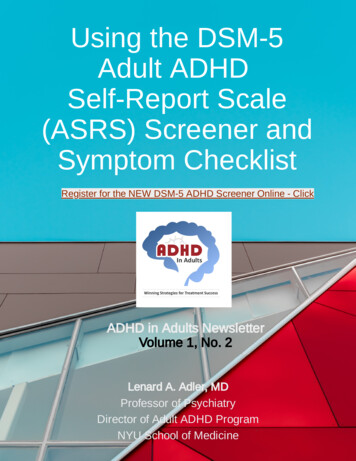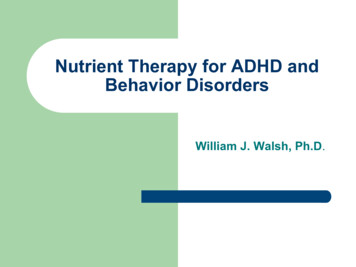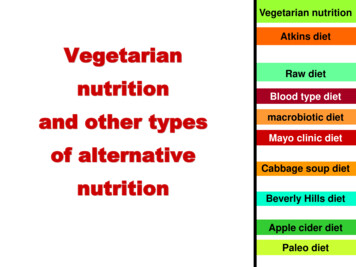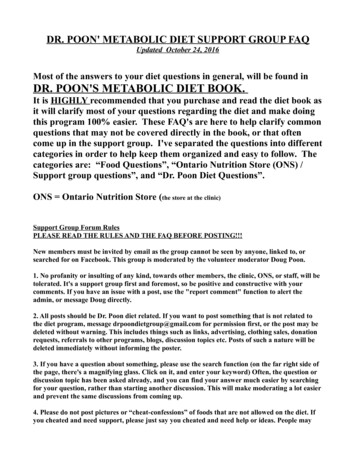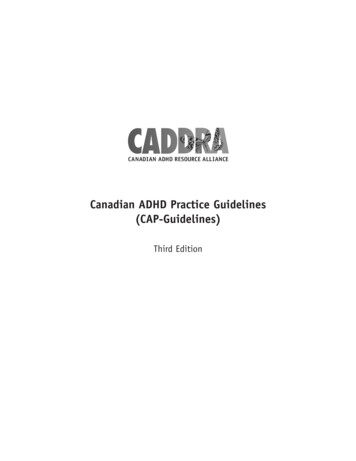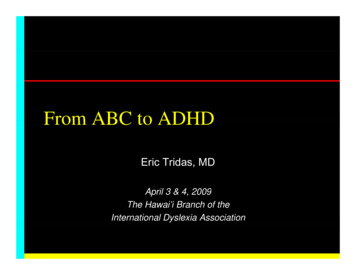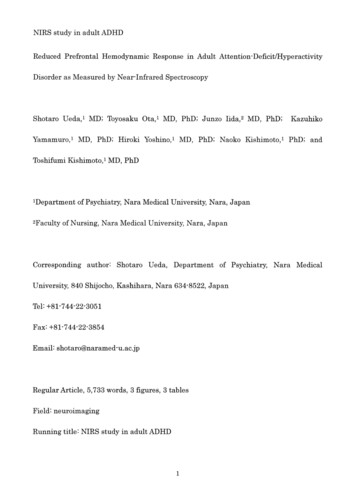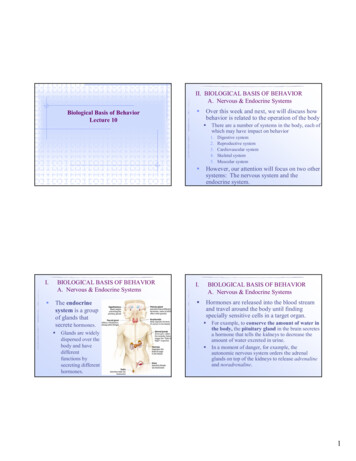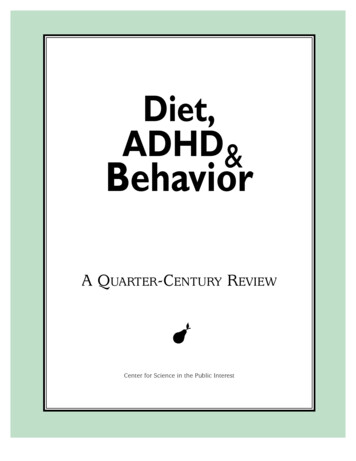
Transcription
Diet,ADHD&BehaviorA QUARTER-CENTURY REVIEWCenter for Science in the Public Interest
Diet,ADHD&BehaviorA QUARTER-CENTURY REVIEWMichael F. Jacobson, Ph.D., and David Schardt, M.S.Center for Science in the Public InterestWashington, D.C.
AcknowledgmentsWe are grateful to numerous people for commenting on early drafts of this report and forhelpful and sometimes challenging discussions. Some of those people are L. Eugene Arnold, MarvinBoris, William Crook, Shula Edelkind, Leo Galland, Jane Hersey, Marcel Kinsbourne, AndrewRowland, and Bernard Weiss. We especially thank Bonnie F. Liebman, CSPI’s director of nutrition,for her careful review and thoughtful comments. However, it is only the authors who areresponsible for the contents of this report and any errors in facts or judgments.The contents of this pamphlet are not intended to provide personal medical advice, which should be obtainedfrom a qualified health professional.Copyright 1999 by Center for Science in the Public InterestFirst Printing: September, 1999. Second Printing: November, 1999.The Center for Science in the Public Interest (CSPI), founded in 1971, is a nonprofithealth-advocacy organization. CSPI conducts innovative research and advocacyprograms in nutrition, food safety, and alcoholic problems and provides consumersand policy makers with current information about those issues. CSPI is supported bythe one million subscribers in the United States and Canada to its Nutrition ActionHealthletter and by foundation grants.Center for Science in the Public Interest1875 Connecticut Ave. NW #300 - Washington, DC 20009Tel: 202-332-9110 - Fax: 202-265-4954P.O. Box 70373 Toronto Station A - Toronto, ON M5W 2X5E-mail: cspi@cspinet.org - World Wide Web: www.cspinet.org
Diet and ADHDi2009 Update on Food Dyes and BehaviorSince “Diet, ADHD, and Behavior” waspublished in 1999, several new studies havebeen published that shed light on diet’sadverse effects on behavior. In addition, publicofficials, particularly in Europe, have begun totake actionResearch and policy action on diet andbehaviorFollowing more than two decades ofresearch on food dyes and hyperactivity, animportant 2004 meta-analysis concluded that“our results strongly suggest an associationbetween ingestion of [synthetic food dyes] andhyperactivity.”1The most important new research wasfunded by the British government. Those twostudies, unlike previous ones, involved a crosssection of young children instead of childrenselected because their parents suspected theirbehavior was impaired by food ingredients. Inone of the studies, University of Southamptonresearchers tested two mixtures of several fooddyes (some of which are used in the UnitedStates), as well as a placebo, over a six-weekperiod.2 (The preservative sodium benzoatewas also included, though there was no reasonto think it affected behavior.) The studyinvolved 153 3-year-olds and 144 children 8 to9. One of the two mixtures significantlyaffected the younger children, while bothmixtures adversely affected older children whoconsumed the additives as directed. Theresearchers’ concluded that “Artificial coloursor a sodium benzoate preservative (or both) inthe diet result in increased hyperactivity in 3year-old and 8/9-year-old children in thegeneral population.”The editors of the American Academyof Pediatrics’ journal, AAP Grand Rounds,stated: “Thus, the overall findings of the studyare clear and require that even we skeptics,who have long doubted parental claims of theeffects of various foods on the behavior of theirchildren, admit we might have been wrong.”3The British Food Standards Agency(FSA) offered this advice to parents: “If a childshows signs of hyperactivity or AttentionDeficit Hyperactivity Disorder (ADHD) theneliminating the colours used in theSouthampton study from their diet might havesome beneficial effects.”4 As a preventivemeasure, the FSA began urging foodmanufacturers to stop using the coloringsstudied. When few companies respondedpromptly, the chair of the FSA board said, “Theboard expresses its astonishment that industryhas not moved more quickly to remove theseartificial colors from their products, in the lightof serious concerns raised by consumers.”5Some of Britain’s biggest supermarket chains—Tesco, Sainsbury’s, ASDA, Marks & Spencer,and the Co-op—have pledged to drop the dyesfrom their house-brand products.6 Marspromised to eliminate the studied additivesfrom its confectionaries in Britain by the endof 2008, but not in the United States.7 Haribohas done the same for its candies.8 Dyes arealso absent from McDonald’s, Nestlé, Kraft,and Kellogg foods in Britain, but not in theUnited States.9In 2008, the European Food SafetyAuthority (EFSA) reviewed the Southamptonstudy and concluded that it “provides limitedevidence that the two different mixtures ofsynthetic colours and sodium benzoate testedhad a small and statistically significant effecton activity and attention in some children ”10However, the EFSA cited several uncertaintiesregarding clinical relevance, small effect size,and that the study could not identify theeffects of individual additives.Following a New York Times articleabout the British study, a committee of theNew York State Assembly held a hearing inOctober 2007 on food additives and behavioraldisorders.11 The chair of the committee, PeterRivera, subsequently called for warning labelson foods containing certain food dyes andsodium benzoate. And in 2009 a Marylandlegislator introduced two bills to phase outdyes from foods in schools or in all foods in
iiDiet and ADHDthe state. Legislators in other states arepreparing similar legislation.But action was more forceful in Europe.In July 2008, the European Parliamentapproved a measure that requires foodscontaining any of the colors used in theSouthampton study to bear a warning noticethat consumption of the food dye(s) “may havean adverse effect on activity and attention inchildren.”12 That law will go into effect in mid2010. In the meantime, the UK is encouragingfood companies to voluntarily stop using thesix colors by the end of 2009 and is informingconsumers of brands and companies that havedone so.13The U.S. Food and Drug Administration(FDA) has done nothing to protect childrenfrom food additives that affect children’sbehavior. Instead, one of its pamphlets, firstissued in 1993, stated: “Although this theorywas popularized in the 1970’s, well-controlledstudies conducted since then have producedno evidence that food color additives causehyperactivity or learning disabilities inchildren.”14 In 2000, five Members of Congressurged the FDA to revise the brochure to reflect“that some ADHD children may benefit fromdietary changes,” but the brochure remainsunchanged on the FDA’s web site.15 An FDAofficial said the agency would review theSouthampton study, but stated: “However, wehave no reason at this time to change ourconclusions that the ingredients that weretested in this study that currently are permittedfor food use in the United States are safe forthe general population.”16The National Institute of Mental Health(NIMH) is America’s leading sponsor ofresearch into causes of and treatments forADHD. In 2000, NIMH director Steven Hymanstated: “research on dietary interventions isconsidered an integral part of the overall effortto develop safe and effective treatments forchildren with ADHD.”17 However, NIMHapparently has not funded any such researchin recent years. Surprisingly, though, in 2008NIMH revised its ADHD booklet, whichpreviously denied any link between diet andbehavior, to acknowledge that food dyes“might make hyperactivity worse.”18In June 2008, the Center for Science inthe Public Interest, with support from twodozen physicians and researchers, formallypetitioned the FDA to ban the use of food dyes.Because a ban would take several years toimplement, the petition recommended animmediate requirement that foods withsynthetic dyes bear a warning notice. Thepetition noted that some food companies havealready switched to safer, natural colorings andthat two large grocery chains, Trader Joe’s andWhole Foods Markets, do not carry any foodsthat contain dyes.Research on the safety of drugs used totreat ADHDWith methylphenidate (Ritalin) havinglong been the drug of choice for treatingmillions of children, safety is an importantissue. As discussed in this report, a 1995National Toxicology Program (NTP) studyfound that methylphenidate causes cancer inmice. The FDA acknowledged19 that the studyfound “a weak signal of carcinogenic potentialand said it would “initiate additional follow-upstudies, including both animal tests andepidemiological studies in humans usingRitalin.” The agency, however, appears not tohave done anything beyond requiring drugcompanies to revise the “label,” which is notprovided to patients and parents, by brieflysummarizing the results of the NTP study. Aletter from seven cancer experts urging theDepartment of Health and Human Services toinform the public of possible risks frommethylphenidate was ignored.20To get direct evidence on the risks ofstimulant drugs, Texas researchersadministered methylphenidate to children forthree months and then examined bloodlymphocyte cells. They found roughly threefold increases in chromosome aberrations,sister chromatid exchanges, and micronucleifrequencies. They concluded that theirfindings were “a cautionary sign” and urgedfurther research, because of the “welldocumented relationship between elevatedfrequencies of chromosome aberrations andincreased cancer risk.”21
Diet and ADHDThe Texas study spurred a larger studyin children. When administered to 25children, methylphenidate and amphetaminedid not appear to cause chromosomal damagein lymphocyte cells after three months oftreatment.22 The authors acknowledged thattheir findings “should not be interpreted ascategorical proof of the long-term safety ofstimulants for the treatment of ADHD” andurged that further research be conducted.Sensitive epidemiology studies of thecarcinogenicity of methylphenidate are difficultto conduct because of the need to include largenumbers of subjects who had consumed thedrug for long periods. Nevertheless, one suchstudy linked the drug’s usage with asignificantly higher incidence of lymphocyticleukemia.23 The researchers emphasized thatthe apparent association might be due tochance.Summary and recommendationsIn a letter to Congress in 2000, OhioState University professor emeritus ofpsychiatry L. Eugene Arnold questioned thecontinued use of food dyes.24 If such dyeswere eliminated from the food supply, thisexpert stated:The only economic segment to sufferwould be the dye manufacturers; that costshould be weighed against the possibility ofsolving 5–15% of the ADHD problem. Wouldsubsidizing the dye industry’s loss be cheaperthan the medical and educational costs of thatproportion of ADHD?Likewise, the authors of the 2004 metaanalysis noted earlier urged that “societyshould engage in a broader discussion aboutwhether the aesthetic and commercialrationale for the use of [artificial foodcolorings] is justified.”25 Such a discussion isparticularly appropriate considering that theper capita production of food dyes increasedfive-fold between 1955 and 2007.26In light of the strong likelihood thatdyes in children’s foods are impairing children’sbehavior, the Center for Science in the PublicInterest recommends the fo l l owing actions:iii Food (and drug) manufacturers should stopusing food dyes, especially in productsconsumed widely by children. Saferalternatives are available. Congress should fund the Institute ofMedicine to evaluate the studies on dietand behavior and on the safety ofpharmaceuticals used to treat ADHD,keeping in mind the benefits and risks offood ingredients and of pharmaceuticals.The IOM should suggest research andregulatory options and more thoroughprotocols for testing new food additives. Congress should hold hearings on theeffects of diet on behavior, includingpossible risks associated with drugs used totreat ADHD, and on the FDA’s response tothe body of research. Congress, statelegislators, and state and local boards ofeducation should consider legislation toban the synthetic dyes. The FDA should revoke the approval offood and color additives that may provokeadverse behaviors. If the FDA fails to dothat, Congress should pass a law to protectchildren from the unsafe ingredients. TheFDA also should require neurobehavioraltesting of new food additives.
Diet and ADHDvContentsExecutive Summary .iiiIntroduction .1Studies on Diet and ADHD.4Studies that found some effect of diet on behavior .4Studies that found little or no effect of diet on behavior .8Discussion .9How many children with ADHD are affected by diet? .10How much dye do children consume? .11Limitations in study designs .11Experts’ denials of effects of diet.12Choosing a treatment: medication or diet? .13Adverse effects of stimulant drugs .13The role of regulation.15Recommendations .16Appendix 1. Sugar and ADHD .17Appendix 2. Studies of Diet and Behavior .18Appendix 3. The Conventional Wisdom on Diet and ADHD .25Appendix 4. Is Your Child Sensitive to Food Ingredients?.29Table 1. Effects of Diet on Behavior (Double-blind Studies) .5Table 2. Effects of Diet on Behavior (Studies not Double-blind) .6Endnotes .31
Diet and ADHDviiExecutive SummaryThis report reviews 23 controlled studiesof the effect of food dyes and other dietaryconstituents on the behavior of children withAttention-Deficit/Hyperactivity Disorder(ADHD) or other behavioral problems. Thoughthe studies are limited due to the number ofsubjects, extent of dietary changes tested,assessment techniques, and other factors, 17of the 23 studies found evidence that somechildren’s behavior significantly worsens afterthey consume artificial colors or certain foods,such as milk or wheat. Limited research withsuch tools as electroencephalography (EEG)indicates that certain foods triggerphysiological changes in sensitive individuals.This report recommends:Notwithstanding the evidence fromnumerous studies, many health organizationsand medical experts deny that diet canprovoke adverse behaviors and that modifieddiets may benefit patients. The NationalInstitute of Mental Health (NIMH) largelydismisses diet as a treatment approach, andthe U.S. Food and Drug Administration (FDA)has cosponsored with an industry tradeassociation a misleading pamphlet that deniesthe effect of diet on behavior. Parents should consider dietary changes(along with behavioral therapy) as thefirst course of treatment for childrenwith behavioral problems before turningto stimulant drugs.Ignoring or denying (or exaggerating) theeffect of diet on behavior is not helpful tochildren and their families. The federalgovernment, the food industry, organizationsconcerned about children with behavioralproblems, and psychiatrists, psychologists, andsocial workers should recognize that dietsometimes can help children who havebehavioral problems. Parents should considermodifying their children’s diets for severalweeks to ascertain any benefit before resortingto medications. That is particularly the casebecause the stimulant drugs routinely used totreat ADHD may cause side effects, and themost commonly used drug, methylphenidate(Ritalin), increased the incidence of livercancer in a study on mice. Of course,modifying a child’s diet can be difficult in asociety in which problem foods are ubiquitous,though perhaps no more difficult thanadhering to a kosher or vegetarian diet. Government, private agencies, andhealth practitioners concerned aboutchildren with ADHD and otherbehavioral problems shouldacknowledge the potential for diet toaffect behavior and should adviseparents to consider modifying theirchild’s diet as a first means oftreatment. Those organizations shouldupdate their publications to describeaccurately the effect of diet on behaviorand the evidence that methylphenidatecaused cancer in mice and may pose arisk in humans. The National Institutes of Health shouldsponsor research to determine which(and to what extent) foods and foodadditives affect behavior, developmethods for identifying children mostsensitive to foods, investigate theunderlying biological bases forsensitivity to dietary constituents,develop techniques to reduce theimpact of foods on children’s behavior,develop techniques for increasing theease and effectiveness of dietarytreatment, conduct animal studies toinvestigate possible long-term effects(carcinogenic, behavioral, reproductive,teratogenic, and other) of stimulantdrugs, conduct long-term studies onlarge numbers of users of stimulantdrugs to identify any adverse effects(such as behavioral disorders, socialproblems, cancer, reproductiveproblems, or other health problems),and study the efficacy of nutritionalsupplements (including fatty acids,minerals, and vitamins) in treatingbehavioral disorders. Also, NIH shouldsponsor a new consensus conference
viiiDiet and ADHDon diet and ADHD/behavior tosupersede a previous inadequateconference. The FDA should require certain newand existing additives to be tested forbehavioral effects. It should considerbanning from foods consumed widelyby children any dyes and otheradditives that affect behavior. The FDAshould stop endorsing literature thatdenies that diet can affect behavior.Also, it should advise the public thatbecause methylphenidate caused livercancer in mice that drug should not bethe primary choice for treating ADHD. Fast-food chains and manufacturers offoods, drugs, and vitamin supplementspopular with children should minimizethe use of dyes and other unnecessaryadditives. Pediatric hospitals and psychiatricclinics, as well as schools and camps,should minimize the use of foodadditives that may contribute tobehavioral disorders.
Diet and ADHD1IntroductionAttention-deficit/hyperactivity disorder(ADHD) is a syndrome diagnosed in millions ofAmerican children and adults.* The mainsymptoms of ADHD are reduced attentivenessand concentration, excessive levels of activity,distractibility, and impulsiveness. Additionalchildren are affected by other behavioralproblems. For the past quarter-century,controversy has swirled around the hypothesisthat diet can trigger symptoms of ADHD andother behavioral problems.The exact percentage of children withADHD is not known. The usual estimates are3 percent to 5 percent of school-age children.27Using broader diagnostic definitions, somesurveys find that the percentage is as high as17 percent.28 School-age boys with thedisorder outnumber girls by a margin ofroughly two or three to one. On average, atleast one child in every classroom in theUnited States needs help for ADHD. Indeed,one recent study found that in 1995 18percent to 20 perent of fifth-grade white boysin two Virginia cities had been diagnosed withADHD and were being treated with stimulantdrugs.29Children often outgrow or learn how tocontrol their symptoms. But symptomssometimes persist into adulthood, making itmore difficult to succeed in careers, to startand maintain families, and to become involvedin community activities. Adults with ADHDhave higher rates of alcoholism, drug use, andimprisonment.30ADHD takes an enormous toll on affectedchildren and their families. The child fallsbehind in school, does not learn what his orher peers are learning, loses self-esteem, andneeds extra help. A family must cope dailywith the need to focus the child’s attention onessential activities or restrain his or herimpulsive behavior. A family must also dealwith the fact that its child is not alwayswelcome in other people’s homes, in playgroups, or on teams. Siblings may sufferbecause their own needs are not met, andmany marriages suffer from the constantstress of dealing with ADHD.ADHD is most often diagnosed with theuse of a checklist of typical behaviors, such asthe one published in the American PsychiatricAssociation’s Diagnostic and Statistical Manualof Mental Disorders–IV (see box on page 2),and by considering other factors, such as ageof onset and degree of impairment. Many ofthe studies on diet and behavior discussed inthis report evaluated children’s behavior bymeans of the 10-item Conners’ Parent-TeacherQuestionnaire, an earlier, widely used meansof identifying hyperactivity.31 Thatquestionnaire rated ten behaviors, such asfailure to finish tasks, fidgeting, excitable/impulsive, restless or overactive, and disturbsother children, on a scale of 0 to 3. Scores of15 or greater indicate hyperactivity.Researchers generally agree that ADHDhas genetic roots. Thus, if one child has thesyndrome, his or her siblings have a greaterrisk of developing it.32 Doctors cannot yetdiagnose ADHD by using blood analyses, brainscans, or other laboratory tests, but researchersare working hard to develop such methods.Recently, researchers have found subtledifferences in brain structure and metabolismbetween children with and without ADHD.33The Feingold dietIn the mid-1970s, Benjamin Feingold, aCalifornia allergist, generated a firestorm ofexcitement and controversy by maintainingthat artificial colorings and flavorings andcertain natural chemicals (salicylates inapricots, berries, tomatoes, and other foods)*ADHD was formerly called hyperactivity or attention-deficit disorder (ADD). The American PsychiatricAssociation’s Diagnostic and Statistical Manual of Mental Disorders (DSM-IV) identifies three types of AD/HD:predominantly inattentive (ADD), predominantly hyperactive (ADHD), and combined subtype (the mostcommon).
2Diet and ADHDcould trigger ADHD.34 Feingold, who was ChiefEmeritus of the Department of Allergy at theKaiser Foundation Hospital and PermanenteMedical Group in San Francisco, stated that30 percent to 50 percent of the hyperactivechildren that he had treated benefited fromdiets free of those substances.35 He discoveredthat when he prescribed a restricted diet (butnot other treatments) for hives, asthma, orother allergic reactions, his patients’ behavioralproblems (if present) sometimes also woulddiminish.Thousands of beleaguered families, eagerfor drug-free relief for their hyperactivechildren, tried Feingold’s diet. Many reportedmarked improvement in their children’sbehavior. Those parents launched Feingolddiet support groups throughout the country toshare information and provide encouragementand help to other families.But not everyone agreed that diet mightaffect children’s behavior. The processed-foodsindustry and many child-behavior experts andresearchers were skeptical of Feingold’s claim,noting that it was based solely on his andparents’ observations and was not supportedby any controlled studies. The reportedsuccesses of his diet could be due tosomething else the families were doing, theysaid, and not to the absence of chemicals inthe food. Until the relationship between dietand behavior was demonstrated in wellconducted research, they insisted, Feingold’sclaim should be considered an unprovenhypothesis. Nevertheless, in 1975 a committeeof the U.S. Department of Health, Educationand Welfare concluded that “the evidencetaken as a whole is sufficient to merit furtherDSM-IV Checklist for Diagnosing ADHDThe Diagnostic and Statistical Manual of Mental Disorders IV, published by the American PsychiatricAssociation, describes three patterns of behavior that indicate ADHD. People with ADHD may showseveral signs of being consistently inattentive. They may have a pattern of being hyperactive and impulsive.Or they may show all three types of behavior.Signs of inattention include: becoming easily distracted by irrelevant sights and sounds failing to pay attention to details and making careless mistakes rarely following instructions carefully and completely losing or forgetting things like toys, or pencils, books, and tools needed for a task avoiding tasks that require sustained mental effortSigns of hyperactivity and impulsivity include: feeling restless, often fidgeting with hands or feet, or squirming running, climbing, or leaving a seat in situations where sitting or quiet behavior is expected acting as if driven by a motor blurting out answers before hearing the whole question having difficulty waiting in line or for a turnBecause everyone shows some of those behaviors at times, the DSM contains specific guidelines fordetermining when they indicate ADHD. The behaviors must appear early in life, before age seven, andcontinue for at least six months. In children, they must be more frequent or severe than in others thesame age. Above all, the behaviors must create a real handicap in at least two areas of a person’s life, suchas school, home, work, or social settings. So someone whose work or friendships are not impaired bythose behaviors would not be diagnosed with ADHD. Nor would a child who seems overly active atschool but functions well elsewhere.(Adapted from Attention Deficit Hyperactivity Disorder, National Institute of Mental Health, 1994.)
Diet and ADHDinvestigation into the relationship of diet andthe hyperkinetic syndrome.”36Slowly, university researchers begantesting Feingold’s claim. The first study,conducted by C. Keith Conners and hiscolleagues at the University of Pittsburgh andpublished in 1976, found that at least four of15 children diagnosed with ADHD improvedon a diet free of artificial colors and flavors,according to evaluations by parents, teachers,and the researcher.37Within the next five years, about a dozencontrolled trials of varying quality wereconducted. In those studies, children withADHD (most of whose parents believed theirbehavior was affected by diet) were either puton a reduced-additive diet and then challengedwith specific additives or provided with dietscontaining (placebo) or not containing (testdiet) those substances. Most of those studiesfound some evidence of a dietary effect onbehavior. (The hypothesis that foodscontaining salicylates affect behavior remainsessentially untested.38)In 1982, the National Institutes of Health(NIH) convened a “consensus developmentconference” on “Defined Diets and ChildhoodHyperactivity.”39 That NIH panel concludedthat food additives and certain foods affect asmall proportion of children with behavioralproblems. The panel stated that controlledstudies “did indicate a limited positiveassociation between defined [Feingold-type]diets and a decrease in hyperactivity.” It notedthat a major limitation of the research was thatmost studies tested only food dyes and notflavors and preservatives that also mightpromote hyperactivity. It recognized “thatinitiation of a trial of dietary treatment . . .may be warranted” for hyperactive children.Also, it recommended that more animal andhuman research be conducted to determine“[Controlled studies] did indicate a limitedpositive association between defined [Feingoldtype] diets and a decrease in hyperactivity.”NIH 1982 Consensus Conference3which foods and additives cause problems,how those ingredients affect the brain andbehavior, and which children may be mostlikely to respond to dietary treatment.During the 17 years since that NIHmeeting, the NIH has sponsored little of theresearch recommended by its consensus panel.Nevertheless, a number of studies conductedby researchers in the United States, Canada,Europe, and Australia provided new evidencethat synthetic colors and possibly otheradditives and foods, such as milk and corn,adversely affect some children with behavioralproblems.The issue of diet and ADHD needs to beconsidered in the context of current treatmentpractices. Pediatricians, though they oftenhave reservations about treating ADHD withmedications, typically prescribe stimulantdrugs for children along with behavioralcounseling for parents and children. The drugmost frequently prescribed is methylphenidate(Ritalin and other brands). The use ofmethylphenidate increased by 2.5-foldbetween 1990 and 1995, according to onestudy, with an estimated 1.5 million youthsaged five to 18 taking the drug in 1995.40 TheU.S. Drug Enforcement Administration (DEA)of the U.S. Department of Justice, which treat
Since “Diet, ADHD, and Behavior” was published in 1999, several new studies have . studies, unlike previous ones, involved a cross-section of young children instead of children . Trader Joe’s and Whole Foods Markets, do not carry any foods t

